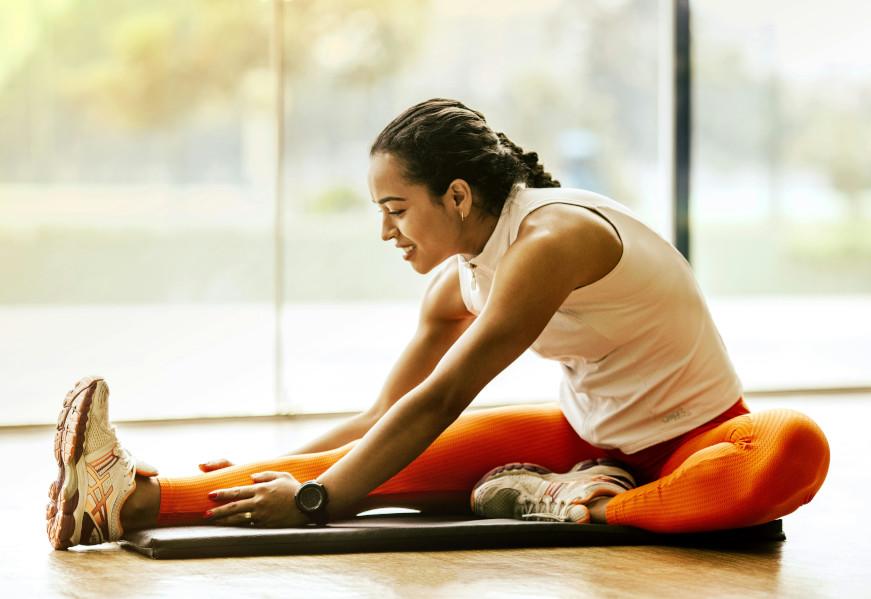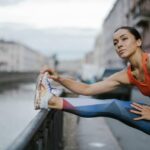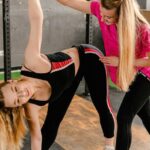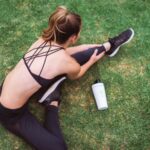Mobility stretches are a critical component of any leg day routine, providing the dual benefits of enhancing flexibility and preparing the muscles for a strenuous workout. Integrating these stretches addresses the range of motion in the joints, allowing for more dynamic movements and decreasing the likelihood of injury during leg exercises. Flexibility, on the other hand, pertains to the ability of the muscles to lengthen. When both mobility and flexibility are optimal, they contribute to a more effective and safer exercise experience.
Leg stretches specifically target the muscles of the lower body, which can become tight due to prolonged sitting or intensive physical activity. By incorporating a series of leg stretches before and after a workout, individuals can ensure that their muscles are properly warmed up, which in turn can lead to better performance and reduced post-exercise soreness. Exercises such as the hip flexor stretch, calf stretch, and hamstring stretch are often recommended as part of a well-rounded leg day mobility routine.
While some may regard mobility stretches as merely a preliminary step to the actual workout, they serve as an essential foundation to a comprehensive leg training program. Through regular implementation, individuals not only minimize the risk of injuries but also enhance their overall athletic performance. Leg day stretches, when performed consistently and correctly, can facilitate a fuller range of motion and contribute to long-term muscle health and functionality.
Fundamentals of Leg Day Mobility
Optimizing leg day performance hinges on the mastery of mobility and the strategic implementation of stretching routines to foster a greater range of motion.
Understanding Mobility and Flexibility
Mobility refers to the ability of an individual to move a muscle or muscle group through its entire range of motion with control. Flexibility is the capacity of a muscle to lengthen passively through a range of motion. Both are vital in performing leg exercises effectively and safely.
The Role of Stretching in Mobility
Incorporating stretches into a leg day routine is crucial for improving mobility. Stretching helps to prepare the muscles for the stresses of weightlifting by warming them up, thus enhancing their functional capacity. This includes dynamic stretches to activate muscles and static stretches to increase flexibility post-workout.
Key Stretches for Leg Muscles
Proper stretching is essential for maintaining flexibility and preventing injuries. The following stretches target the major muscle groups in the legs: the quadriceps, hamstrings, and calf muscles. These stretches aid in muscle recovery and growth.https://www.youtube.com/embed/N5xKh13Yuqk
Quadriceps Stretches
To effectively stretch the quadriceps, one can execute a simple standing quad stretch. To begin, they should stand on one leg, pull the other foot towards the buttocks, and hold it there with their hand. They should keep their knees close together and their body straight, aiming to hold the stretch for at least 20 seconds before switching sides.
Hamstring Stretches
For the hamstrings, a toe-touch stretch is beneficial. Individuals should stand with feet hip-width apart and slowly bend forward at the waist, reaching toward their toes while keeping legs straight. To avoid strain, they need not touch their toes; the goal is to feel a gentle stretch in the hamstrings. Holding this position for 15-30 seconds can effectively stretch these muscles.
Calf Muscle Stretches
Stretching the calf muscles can be accomplished through a wall push-up stretch. Facing a wall, individuals place their hands at about chest level. Placing one foot in front of the other, they gently lean into the wall while keeping the back leg straight and the heel on the ground. They should feel a stretch in the calf muscle of the back leg as they hold this position for 15-30 seconds, then switch legs.
Dynamic Warm-Up for Lower Body
To maximize performance and reduce the risk of injury, dynamic stretches targeting the lower body should form the essential beginning of any leg day routine. They help increase blood flow to muscles, improve hip mobility, and prepare the lower back for exercise.
Dynamic Stretching Benefits
Dynamic stretches involve active movements that help the body stretch while also moving. This type of stretching warms up the muscles, making them more flexible and ready for strenuous activity. They improve blood flow and increase body temperature, which can enhance muscle elasticity. Incorporating dynamic stretches in a warm-up routine specifically benefits the lower back and hips, areas pivotal for lower body exercises.
- Spiderman Lunge with Thoracic Rotation: A compound move that opens hips and thoracic spine.
- Inchworms: Encourages hamstring stretch while activating core and strengthening the lower back.
- Good Mornings: Focuses on the posterior chain to improve hamstring and lower back flexibility.
Implementing a Dynamic Leg Day Warm-Up
A well-structured dynamic leg day warm-up includes a series of movements designed to engage multiple muscle groups relevant to the workout. A good rule of thumb is:
- Start with 5-10 minutes of light cardio to get the heart rate up.
- Move on to specific dynamic stretches, performing 5-10 repetitions on each side of the body, with particular focus on hip mobility. This can include:
- Leg swings (frontal and lateral)
- Walking lunges
- Bodyweight squats
Key Movements:
- Leg Swings: Enhance hip mobility and prepare the legs for compound movements.
- Walking Lunges: Activate the glutes, hips, and thighs, encouraging stability and coordination.
- Bodyweight Squats: Prime the major muscles used in squatting movements.
By integrating these exercises into the warm-up, individuals can ensure their lower back and hips are properly prepped for the workout ahead, leading to potentially better performance and a reduced risk of injury.
Static Stretches for Post-Workout Recovery
Incorporating static stretches after a workout is essential for aiding recovery and mitigating muscle soreness. These stretches help elongate the muscles, promoting flexibility and reducing tension.
Lower Body Static Stretching Routine
One should engage in a series of lower body stretches focusing on key muscle groups impacted during leg day. A recommended routine includes:
- Calf Stretch: Position yourself with one foot forward, knee bent, and the other leg extended back, heel flat on the ground. Lean into the lead leg and hold for 45 seconds. Switch legs and repeat.
- Hamstring Stretch: Sitting on the ground, extend one leg out and fold the other so the foot touches the extended leg’s knee. Reach forward towards your toes, hold your shin if toes are not reachable, and maintain for 30 to 45 seconds. Alternate legs.
- Quadriceps Stretch: Stand on one leg, bending your opposite leg at the knee, and pull your heel towards your buttocks. Hold onto something for balance if needed and sustain the position for 30 seconds. Switch to the other leg.
- Glute and Piriformis Stretch: While lying on your back, cross one leg over the other thigh, and gently pull the knee towards your chest. Keep this hold for at least 30 seconds before switching sides.
Optimizing Recovery With Static Stretches
For optimal recovery, static stretches should be performed when muscles are warm, generally after a workout session. It’s important to:
- Hold each stretch for a minimum of 30 seconds, as this duration can help effectively increase flexibility.
- Breathe deeply to assist with relaxation and promote oxygen delivery to the muscles.
- Avoid bouncing or overstretching, as this can cause injury.
By following this structured approach, individuals can enhance their post-workout recovery and reduce the occurrence of lower body muscle soreness.
Injury Prevention and Pain Management
Incorporating specific stretches into a leg day routine can significantly reduce the risk of injuries and manage existing pain. These preventive measures optimize performance and aid in quicker recovery.
Leg Day Injuries and How to Avoid Them
Leg day injuries typically stem from overexertion, poor form, or insufficient warm-up and cool-down routines. A common leg injury is a strain, which occurs when muscles or tendons are overstretched or torn. Athletes can avoid such injuries by ensuring proper technique and gradually increasing the intensity of their workouts. It is crucial to listen to one’s body and to not push beyond what it is currently capable of handling.
Another key to injury prevention is maintaining muscle balance. Inconsistencies in strength and flexibility between opposing muscle groups can lead to uneven stress distribution. A physical therapist can help identify these imbalances and recommend appropriate exercises to correct them.
Stretching to Alleviate Pain
Stretching plays a pivotal role in managing leg pain post-exercise. Targeted stretching helps alleviate stiffness and increases blood flow to the muscles, aiding in the recovery process. The stretches should focus on the major leg muscle groups: hamstrings, quadriceps, calves, and hip flexors.
- Hamstrings: A simple standing or seated forward bend can relax tight hamstrings.
- Quadriceps: While standing, bring the heel toward the buttocks, holding the ankle to stretch the front of the thigh.
- Calves: With hands against a wall, step one foot back, pressing the heel into the ground until a stretch is felt in the calf muscle.
- Hip Flexors: Perform lunges with a straight back, sinking the hips forward to stretch the front of the hip.
Users should hold each stretch for at least 20-30 seconds to ensure the muscle fibers sufficiently elongate. Stretching should not cause pain. If pain is experienced, they should cease the stretch and consult a healthcare provider.
Improving Performance Through Mobility Work
Effective mobility exercises can profoundly impact squat performance and overall athletic capabilities. They bridge the gap between basic flexibility and the functional strength required during training.
Mobility Exercises for Better Squats
Incorporating specific mobility exercises into a leg day routine can greatly enhance squat performance. A well-executed squat relies on the flexibility and strength of the lower body musculature.
- Ankle Mobility: To prevent the heels from lifting and ensure stability, perform calf stretches. A flexible ankle allows for a deeper squat position without compromising form.
- Stand arm’s length from a wall.
- Place one foot behind the other.
- Keep the back leg straight and heel on the ground.
- Bend the front knee and lean forward towards the wall, feeling a stretch in the calf of the back leg.
- Hold for 30 seconds and switch legs.
- Hip Flexor Stretch: Hip flexibility aids in achieving the necessary depth for a squat.
- Begin in a half-kneeling position, with one foot flat on the ground (right knee bent at 90 degrees) and the other knee (left) on a mat.
- Tighten the glutes, brace the core, and lean forward slightly.
- Hold for 20-30 seconds for each leg.
Enhancing Athletic Performance with Stretches
Athletes across disciplines can benefit from incorporating stretches into their routines, resulting in increased flexibility and a reduction in muscle imbalances which can lead to enhanced performance and reduced injury risks.
- Dynamic Leg Swings: Perform frontal and lateral leg swings to promote dynamic flexibility in the hamstrings and adductors.
- Hold onto a stable surface with one hand.
- Swing the opposite leg forward and back for frontal swings.
- Swing the leg sideways across the body for lateral swings.
- Do 10-15 swings for each leg.
- Hamstring Stretch: Keeping the hamstrings limber is vital for sprinting, jumping, and numerous sports movements.
- Sit on the ground with one leg extended forward.
- Bend the opposite knee, placing the sole of the foot against the inner thigh of the extended leg.
- Lean forward from the hips towards the foot of the straight leg.
- Hold for 30 seconds and repeat on the other side.
Through targeted mobility exercises for squats and stretches aimed at enhancing athletic performance, individuals can expect to see improvements in their training outcomes and a much more robust athletic profile.
Advanced Mobility Techniques and Tools
In the pursuit of enhanced leg day performance, athletes can leverage advanced mobility techniques and specialized tools to target key muscle groups and improve flexibility. Utilizing props such as foam rollers, and integrating disciplines like yoga and Pilates, can significantly elevate mobility.
Incorporating Props Like Foam Rollers
Foam rollers offer a self-myofascial release technique for the improvement of flexibility and relief of muscle tightness. Athletes may use foam rollers for their hip adductors, a crucial group of muscles for balance and stability during leg exercises. A typical routine may include:
- Intensity: Roll slowly on the foam roller, applying moderate pressure to tender areas. Maintain control to avoid injury.
- Duration: Spend at least 30 seconds to 1 minute on each muscle group.
| Muscle Group | Technique |
|---|---|
| Quadriceps | Face down, place the foam roller under thighs. Roll from above the knee to the hip, pausing on any tight spots. |
| Hamstrings | Sit with legs extended, roller underneath. Roll from knees to glutes, focusing on tight areas. |
| Hip Adductors | In a side-lying position, place the roller near the groin area of the extended leg and roll toward the inner thigh. |
| Calves | In a seated position, place the roller under the calves, move from the ankle to below the knee with steady pressure. |
Proper use of foam rollers can help increase mobility for more strenuous leg workouts, emphasizing the importance of technique and consistency.
Yoga and Pilates for Leg Day Mobility
Yoga and Pilates incorporate controlled movements that can enhance strength, balance, and flexibility, pivotal for leg day success. They integrate poses and exercises that specifically target the hip adductors, promoting increased range of motion.
- Yoga: Utilizes static holds and stretches that demand balance and concentration. Poses like the “Warrior II” and “Extended Triangle” stretch the hip adductors, while “Downward Dog” can engage the entire lower body.
- Pilates: Focuses on control and precise movements. Exercises like the “Side Lying leg lift” or “Pilates Scissors” work on the inner thighs, core stability, and coordination for comprehensive leg mobility.
Each discipline offers a range of benefits that complement a leg day routine, ensuring that the body moves fluidly and with a greater degree of freedom. Incorporating these practices regularly can lead to better performance and reduced risk of injury.
Frequently Asked Questions (FAQs)
What stretches should one do after leg day? One should focus on stretches that target the muscles used during leg day. This includes stretches for the hip flexors, quadriceps, hamstrings, and calves. Holding a stretch for 10-20 seconds can be beneficial.
Is it essential to be certified to teach leg day stretches? While anyone can perform stretches, those who are certified, especially by a recognized organization like the American College of Sports Medicine (ACSM), have a verified depth of knowledge on safe stretching techniques and can provide valuable guidance.
What are the benefits of mobility stretches before leg day? Mobility stretches before leg day can improve hip mobility, activate muscles, and increase the range of motion, thus preparing the body for the workout ahead.
How often should one stretch on leg day? One should stretch both before and after a leg workout. Beforehand, dynamic stretches are recommended to prepare the muscles. Post-workout, static stretches can aid in recovery.
| Stretch Type | When to Do | Reps |
|---|---|---|
| Dynamic | Pre-Workout | 5-10 |
| Static | Post-Workout | Hold 10-20s |
Can stretching improve leg day performance? Yes, stretching can contribute to better performance by preparing the muscles for exercise and by potentially decreasing the risk of injury. It may also help with post-exercise recovery.








